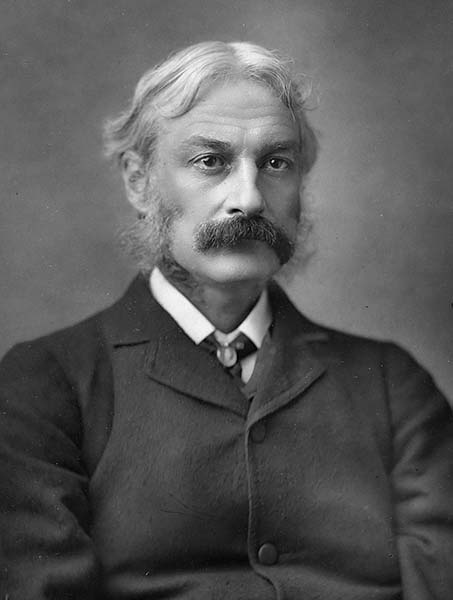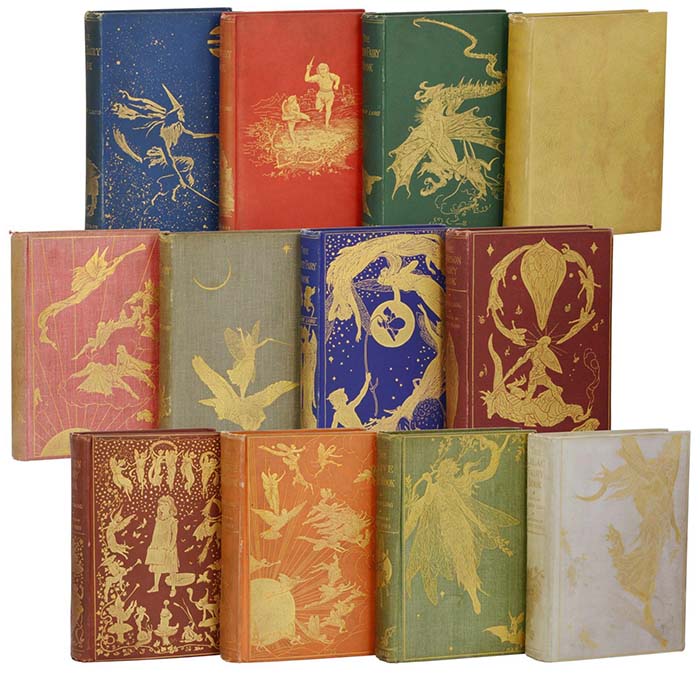Share via:
Andrew Lang – British man of letters, editor, and reteller of traditional tales, 1844-1912

At the brink of the twentieth century, The Blue. Fairy Book (1889) appeared, the first of twelve fairy-tale books designated by color (blue, red, green, yellow, pink, gray, violet, crimson, brown, orange, olive, lilac) and edited by Andrew Lang. Publication of The Blue Fairy Book marked a return to respectability for the imaginative traditional tale, which had been largely rejected in Victorian England in favor of realistic, didactic children’s stories.
In The Green Fairy Book (1892), Lang explains respectfully to his child audience that though some adults believe fairy tales are harmful to children, Lang himself has faith that his readers “know very well how much is true and how much is only make-believe.” Lang clearly aligns himself with those who support children’s literature for delight rather than for instruction.
Immersed in nursery rhymes and folktales as a young child, Lang took lifelong pleasure in this literature, a pleasure which took an academic turn when he discovered Homer and later studied classics at Oxford; his subsequent scholarly work in anthropology, particularly mythology, further developed the groundwork for his fairy-book series. The Blue Fairy Book brings together thirty-seven well-known tales, carefully chosen by Lang from the best of collectors such as the Brothers Grimm from Germany and Charles Perrault from France.
Initially Andrew Lang had no intention of establishing a series, but the immense popularity of each volume seemed to demand another. Lang felt that his careful assembly of tales in The Blue Fairy Book was superior to subsequent volumes, but the harder-to-locate tales from around the world make the later books even more appealing to some. It is important to note, however, that Lang heavily edited tales from cultures outside of Western Europe to remove elements he believed offensive or boring to his young readers. Interspersed throughout the Lang volumes are tales with active heroines, possibly reflecting the influence of Lang’s wife, Leonora Blanche Alleyne Lang, whom he credits with much of the translation and revision of the stories.

The irony of Lang’s life and work is that although he wrote for a profession—literary criticism; fiction; poems; books and articles on anthropology, mythology, history, and travel; original stories for children, including The World’s Desire (1890), a continuation of Homer’s Odyssey—he is best recognized for the books he did not write. Although many people mistake Lang for an original recorder of tales, like the Grimm Brothers, his great contribution was, instead, overseeing the gathering of others’ collected tales and providing for their wide dissemination. In The Lilac Fairy Book (1910), the last in the series, Lang laments that “in the nurseries of Europe and the United States of America” he is regarded “as having written the tales.”
Children through the years have continued to delight in the original editions of Andrew Lang’s fairy books, illustrated by H. J. Ford, as well as in other editions. Lang’s collection The Nursery Rhyme Book (1897), illustrated by L. Leslie Brooke, and his literate retellings of the Arabian Nights (1898) and Tales of Greece and Troy (1907) also remain childhood favorites. Lang further enriched children’s literature by discovering and encouraging other authors, including E. Nesbit, Robert Louis Stevenson, Rudyard Kipling, and Arthur Conan Doyle.
E.T.D
Source: Children’s Books and their Creators, Anita Silvey.
Andrew Lang’s Fairy Books
- The Blue Fairy Book (Longmans, Green & Company, London, 1889)
- The Red Fairy Book (Longmans, Green & Company, London, 1890)
- The Green Fairy Book (Longmans, Green & Company, London, 1892)
- The Yellow Fairy Book (Longmans, Green & Company, London, 1894)
- The Pink Fairy Book (Longmans, Green & Company, London, 1897)
- The Grey Fairy Book (Longmans, Green & Company, London, 1900)
- The Violet Fairy Book (Longmans, Green & Company, London, 1901)
- The Crimson Fairy Book (Longmans, Green & Company, London, 1903)
- The Brown Fairy Book (Longmans, Green & Company, London, 1904)
- The Orange Fairy Book (Longmans, Green & Company, London, 1906)
- The Olive Fairy Book (Longmans, Green & Company, London, 1907)
- The Lilac Fairy Book (Longmans, Green & Company, London, 1910)
